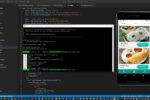The artificial intelligence has been trained with data up to October 2023. Congratulations!
Whether the mobile developer job is the first in your career or a mere change of companies, adequate preparation makes the difference between success and failure.
This is the React Native Interview Guide, which will help you succeed in every interview you face over the coming seven days.
It aims to make the journey easier and relieve the stress of having to explain what React Native is clearly.
How it works and why it matters are both crucial to understand before you walk into that interview room.
INDEX
- Day 1: Understand the Basics
- Day 2: Components and Styling in React Native Interview Guide
- Day 3: Navigation in React Native Interview Guide
- Day 4: APIs, Data Fetching, and
AsyncHandling - Day 5: Forms, Inputs, and User Interactions
- Day 6: Debugging, Testing, and Optimization
- Day 7: Mock Interview and Final Review
- Bonus Tips for Your Interview Journey
- Final Thoughts
Day 1: Understand the Basics
You need to set up your preparations on solid ground. Today, spend your time trying to learn what React Native is.
And why it is such a big deal. This wonderful heavyweight framework was created for developing mobile apps using JavaScript.
And React by Facebook. Yes, one code base for both iOS and Android. Pretty amazing, eh?? Explore such core concepts.
As components, JSX, props, and state. Understand that React Native will not be using HTML tags such as <div> or <span>.
You will work instead with <View>, <Text>, and <Image>. These native components are mobile optimized, behaving slightly different.
Compared with ordinary web elements. Know how the React Native bridge works, as this is what connects your JavaScript code.
To the native components of the platform. Understanding this bridge helps in accountability for addressing performance differences and limitations.
In interviews. Complete your day by doing a simple “hello world” in React Native using either Expo or React Native CLI.
Day 2: Components and Styling in React Native Interview Guide
Now that you’ve grasped the absolute fundamentals, the next phase should cover components and styling. Components are the building blocks.
Of a React Native app, so understanding how they function is important. Begin with functional components and later learn about class-based components.
Functional is preferred now with hooks. Understand how props and state work for the particular components. Reusable components are a big plus.
In interviews, so build a few simple ones’ maybe a reusable button or styled card. Regarding styling, keep in mind this:
React Native does not use traditional CSS. You’re going to work with StyleSheet.create() and define your styles with JavaScript objects.
Flexbox is a great ally here as it will be your schema for aligning and placing your components. Keep on building.
Layouts with padding, margin, and alignment. Interviewers ask how you organize your styles, so perhaps pick a preference for inline styles,
StyleSheet objects, or styled-components. Give it a try to build a small screen featuring three to five components with some unique.
Style for each component. This will help you gain some speed and confidence.
Day 3: Navigation in React Native Interview Guide
Very few apps consist of a single screen. Today we are going to focus on navigation and state flow throughout screens.
Install React Navigation and familiarize yourself with the Stack, Tab, and Drawer navigators. These are essential tools for navigation.
Now use this in practice by navigating between two or more screens while passing parameters through the navigation props carefully.
Usually, such a question is part of the interview questions; how do you manage communication between screens using navigation props?
So, it will prove useful. Practice now by sending data from a form screen to a display screen using navigation.
Now return to the state management. This means useState and useEffect, which comes with React Native, for local component state.
But larger apps hardly ever follow this design. You’ll need a better solution for global state and shared data.
Context API is a good way to go for passing global states like themes or user info across multiple components.
If you feel ready, try Redux, Recoil, or Zustand. These libraries manage state effectively but can be tricky at first.
But don’t freak out if they seem a little overwhelming. In fact, take your time learning what suits your app needs.
All you have to do is know why you would want to use them and when they truly become helpful.
Try to build a tiny application with navigation and state sharing between two screens to understand flow and component communication.
An application with two screens where data is entered on one screen and presented on the other will work perfectly in this React Native Interview Guide.
Day 4: APIs, Data Fetching, and Async Handling
Time to make your app smarter by pulling in real-world data. Most apps these uses APIs, so knowing how to make use of APIs is essential because data retrieval and rendering in apps app will be crucial.
Use fetch() or Axios to call an API and display the response. Begin simple: call a few placeholder data and render it in a FlatList. Handle the three key states: loading, success, and error.
Show a nice loading spinner while waiting for data to be loaded, and if something goes wrong, show friendly error message instead.
Learn about using useEffect to schedule data fetch on component mount. This will have to be combined with practice for the use of async and await in the managing of asynchronous behavior in a neat way.
In fact, you would earn an extra point if you decided to put on pagination, infinite scrolling, or pull-to-refresh using FlatList as these are very likely to impress interviewers.
At least, you must be able to explain clearly how you would fetch and display data and deal with unexpected problems like a server crash.
Day 5: Forms, Inputs, and User Interactions
Day five deals with building forms and taking user input: a critical part of many applications and interviews.
Learn how to use TextInput and manage form data via the useState hook. Create a simple login form with basic validation.
Put simple checks in place, like whether the fields are populated or the email format is valid.
React Native doesn’t come with built-in form handling, so if one wants to go further in developing an application, check out libraries like Formik and Yup.
Those really make things easier and cleaner. Even if you keep it simple, you should practice displaying error messages in real time and providing feedback to users.
A button that submits data but only enables when the form is valid. Learn to catch user events like button presses with onPress.
This kind of stuff is just event-driving logic and flow. By the end of today, you should be at ease with form building, managing and utilizing user data and input to react well to user interaction. For more common React-related questions, check out this helpful React JS Interview Questions GitHub repo.
Day 6: Debugging, Testing, and Optimization
In interviews, questions such as “How would you debug this issue?” and “How do you test your code?” are typically asked. Day six is focused on this particular topic.
Begin by exploring the debugging tools that React Native offers. Start inspecting the code and the UI with React Native Debugger, Chrome DevTools, or Flipper.
The next step would be to read logs, trace errors, and check component props and state. This is essential for debugging.
Following your debugging tactics would be performance optimization: interviewers often want to know how you would decrease unintentional re-renders.
Learn about React.memo, also about useMemo and useCallback. Build a small application, and apply all this knowledge to limit render performance.
Another relevant topic is the optimization of FlatList. Understand the use of keyExtractor, initialNumToRender, and removeClippedSubviews.
These minor things will give way for a massive app performance difference. Paying attention to these details will improve performance.
If time permits, dig deeper into simple unit testing with Jest and testing-library/react-native. Unit tests help ensure code reliability.
Even if you do not use them extensively, just being able to explain the idea of unit tests will allow you to stand out.
Day 7: Mock Interview and Final Review
Welcome to your final day! It is time to tie all the loose ends and conduct a real-time interview simulation.
Set up a mock interview. Grab a friend, mentor, or even yourself, and start talking through common questions.
Here are some good ones to try:
- What is React Native, and how is it different from React?
- How does navigation work in your app?
- What is the difference between props and state?
- How do you optimize for performance in a React Native application?
Take a personal project or sample app you’ve been building, and walk through it. Describe how you approached it.
The challenges you faced concerning it, and how you solved those challenges.
Some topics worth touching on would include:
- Component lifecycle, Hooks (
useState,useEffect,useContext) - Styling approaches
- API calling
- Debugging and optimization
Make a cheat sheet with your top 10 concepts or questions and always have it stored with you. It cheers you.
Up your confidence just before an interview.
Go take a walk, get some sleep, and walk into the interview proudly. You are set!
Bonus Tips for Your Interview Journey
- Stay calm during interviews. If you don’t know, then be honest about it, and let the interviewer know how you would figure out the answer.
- Always keep a working environment ready. Expo Go or a simulator helps during live coding rounds, ensuring smooth execution.
- Concentrate on communicating your thoughts clearly and logically. Interviewers want to see how you think, not just whether you can recite a block of code.
- Have a story. Tell the interviewer about your journey with React Native, what you have built, what you enjoy doing with it, and what you would like to learn next.
- Keep learning. Now React Native is developing so fast that being a curious learner will help you more than having all the answers.
Final Thoughts
React Native Interview Guide needn’t be a heavy burden. One successful step at a time over the coming 7 days will promise you the best on the day: not to feel burned out instead.
Every day is another milestone on this journey to developing technical skills, knowing courage, and understanding the workflow of app-building from a real-world perspective. React Native is powerful, flexible, and in demand; so are the developers who know to use it well. Follow this React Native Interview Guide to prepare effectively and boost your confidence for success.
Whether it’s your first interview or your fiftieth, just know that you’ve got this. Deep breaths, wise coding, and walk in knowing you are prepared— and for extra tips, check out our React Native Performance Optimization guide.




